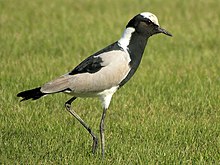Lapwing
| Lapwings | |
|---|---|

| |
| Blacksmith lapwing (Vanellus armatus) | |
| Scientific classification | |
| Domain: | Eukaryota |
| Kingdom: | Animalia |
| Phylum: | Chordata |
| Class: | Aves |
| Order: | Charadriiformes |
| Family: | Charadriidae |
| Subfamily: | Vanellinae Bonaparte, 1842 |
Genera
| |
|
| |
Lapwings (
The traditional terms "plover", "lapwing", and "dotterel" do not correspond exactly to current taxonomic models; thus, several of the Vanellinae are often called plovers, and
In Europe's Anglophone countries, lapwing refers specifically to the northern lapwing, the only member of this group to occur in most of the continent and thus the first bird to go by the English name lapwing (also known as peewit or pyewipe).
In the fanciful taxonomy promoted by medieval courtesy books, a group of lapwings was called a "deceit".[1]
Systematics
While authorities generally agree that there are approximately 25 species of Vanellinae, classifications within the subfamily remain confused. Some workers[
Many coloration details of the red-kneed dotterel also occur here and there among the living members of the main lapwing
Evolution
The
A mid-
The
Apart from the
The remaining
List of species in taxonomic order
Genus Vanellus
- Northern lapwing, Vanellus vanellus
- White-headed lapwing, Vanellus albiceps
- Southern lapwing, Vanellus chilensis
- Grey-headed lapwing, Vanellus cinereus
- Crowned lapwing, Vanellus coronatus
- Long-toed lapwing, Vanellus crassirostris
- River lapwing or spur-winged lapwing, Vanellus duvaucelii
- Red-wattled lapwing, Vanellus indicus
- Masked lapwing, Vanellus miles
- Spur-winged lapwing or spur-winged plover, Vanellus spinosus
- Banded lapwing, Vanellus tricolor
- Blacksmith lapwing, Vanellus armatus
- Black-headed lapwing, Vanellus tectus
- Yellow-wattled lapwing, Vanellus malabaricus
- Senegal lapwing, Vanellus lugubris
- Black-winged lapwing, Vanellus melanopterus
- African wattled lapwing, Vanellus senegallus
- Spot-breasted lapwing, Vanellus melanocephalus
- Brown-chested lapwing, Vanellus superciliosus
- Javanese wattled lapwing, Vanellus macropterus
- Sociable lapwing, Vanellus gregarius
- White-tailed lapwing, Vanellus leucurus
- Andean lapwing, Vanellus resplendens
Genus Hoploxypterus
- Pied lapwing, Hoploxypterus cayanus
Genus Erythrogonys
- Red-kneed dotterel, Erythrogonys cinctus
Footnotes
- ISBN 978-0-670-30044-0.
- ^ Piersma & Wiersma (1996), Thomas et al. (2004)
- ^ a b Piersma & Wiersma (1996)
- ^ Piersma & Wiersma (1996), Mlíkovský (2002)
- ^ Not Dolichopterus, contra Mlíkovský (2002)
- ^ Mlíkovský (2002)
- ^ Campbell (2002)
References
- Campbell, Kenneth E. Jr. (2002). A new species of Late Pleistocene lapwing from Rancho La Brea, California [English with Spanish abstract]. DOI:10.1650/0010-5422(2002)104[0170:ANSOLP]2.0.CO;2 HTML abstract and first page image
- Mlíkovský, Jirí (2002). Cenozoic Birds of the World, Part 1: Europe. Ninox Press, Prague.
- Piersma, Theunis & Wiersma, Popko (1996). Family Charadriidae (Plovers). In: del Hoyo, Josep; Elliott, Andrew & Sargatal, Jordi (eds.): ISBN 84-87334-20-2
- Thomas, Gavin H.; Wills, Matthew A. & Székely, Tamás (2004). A supertree approach to shorebird phylogeny.

